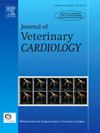Antidiuretic hormone concentrations in dogs with heart disease and relationship to serum chloride
IF 1.3
2区 农林科学
Q2 VETERINARY SCIENCES
引用次数: 0
Abstract
Introduction/objectives
Non-osmotic antidiuretic hormone (ADH) release promotes electrolyte-free water retention in dogs with congestive heart failure (CHF), contributing to low electrolyte concentrations. We hypothesized that dogs with CHF would have higher ADH concentrations than healthy dogs and dogs with preclinical heart disease, and that ADH concentrations would positively correlate to the amount of chloride [Cl−] correction but not serum osmolality.
Animals, Materials and Methods
The study population comprised 20 healthy, 20 preclinical, and 20 CHF dogs. Serum electrolytes, serum osmolality, and plasma ADH were measured and compared between groups using the Kruskal–Wallis test. Relationships between ADH and electrolytes, the amount of [Cl−] correction, osmolality, and the use of amlodipine and renin-angiotensin-aldosterone system inhibitors were explored with multiple linear regression.
Results
Preclinical (median 6.5 pg/mL; range 1.8 pg/mL–33.8 pg/mL) and CHF (6.7 pg/mL; range 2.0 pg/mL–28.1 pg/mL) dogs had higher ADH concentrations than healthy dogs (median 3.4 pg/mL; range 0.1 pg/mL–6.2 pg/mL) (P=0.004) but there was no difference between preclinical and CHF dogs. Serum ADH was inversely correlated with [Cl−] (P=0.026, rs = −0.287) and c[Cl−] (P=0.008, rs = −0.338). Amlodipine use and [Cl−] predicted ADH after controlling for age, weight, use of renin-angiotensin aldosterone inhibitors, and osmolality. There was no significant relationship between ADH and the amount of [Cl−] correction, osmolality, or serum sodium.
Discussion
The inverse relationship between ADH and serum [Cl−] and the positive relationship with amlodipine use suggests neurohormonal stimulation as a common mechanism.
Uncoupling of ADH from osmolality and serum sodium is consistent with non-osmotic release, which was present even in dogs with preclinical heart disease.
Conclusions
Antidiuretic hormone was elevated in dogs with heart disease but was not a unique feature of advanced heart disease.
心脏病犬抗利尿激素浓度与血清氯化物的关系
非渗透性抗利尿激素(ADH)的释放促进充血性心力衰竭(CHF)犬的无电解质水潴留,导致电解质浓度降低。我们假设患有CHF的狗的ADH浓度高于健康狗和患有临床前心脏病的狗,并且ADH浓度与氯离子[Cl−]校正量呈正相关,而与血清渗透压无关。动物、材料和方法研究人群包括20只健康犬、20只临床前犬和20只CHF犬。采用Kruskal-Wallis试验测定血清电解质、血清渗透压和血浆ADH,并比较各组之间的差异。通过多元线性回归探讨ADH与电解质、[Cl−]校正量、渗透压以及氨氯地平和肾素-血管紧张素-醛固酮系统抑制剂的使用之间的关系。结果临床前期(中位6.5 pg/mL;范围1.8 pg/mL - 33.8 pg/mL)和CHF (6.7 pg/mL;范围2.0 pg/mL - 28.1 pg/mL),狗的ADH浓度高于健康狗(中位数3.4 pg/mL;范围0.1 pg/mL - 6.2 pg/mL) (P=0.004),但临床前和CHF犬之间无差异。血清ADH与[Cl−](P=0.026, rs = - 0.287)、c[Cl−](P=0.008, rs = - 0.338)呈负相关。在控制年龄、体重、使用肾素-血管紧张素醛固酮抑制剂和渗透压后,氨氯地平的使用和[Cl−]预测ADH。ADH与[Cl−]校正量、渗透压或血清钠之间无显著关系。ADH与血清[Cl−]呈负相关,与氨氯地平使用呈正相关,提示神经激素刺激是ADH的共同机制。ADH与渗透压和血清钠的解耦与非渗透性释放一致,即使在患有临床前心脏病的狗中也存在这种情况。结论利尿激素在心脏病犬中升高,但不是晚期心脏病犬的特有特征。
本文章由计算机程序翻译,如有差异,请以英文原文为准。
求助全文
约1分钟内获得全文
求助全文
来源期刊

Journal of Veterinary Cardiology
VETERINARY SCIENCES-
CiteScore
2.50
自引率
25.00%
发文量
66
审稿时长
154 days
期刊介绍:
The mission of the Journal of Veterinary Cardiology is to publish peer-reviewed reports of the highest quality that promote greater understanding of cardiovascular disease, and enhance the health and well being of animals and humans. The Journal of Veterinary Cardiology publishes original contributions involving research and clinical practice that include prospective and retrospective studies, clinical trials, epidemiology, observational studies, and advances in applied and basic research.
The Journal invites submission of original manuscripts. Specific content areas of interest include heart failure, arrhythmias, congenital heart disease, cardiovascular medicine, surgery, hypertension, health outcomes research, diagnostic imaging, interventional techniques, genetics, molecular cardiology, and cardiovascular pathology, pharmacology, and toxicology.
 求助内容:
求助内容: 应助结果提醒方式:
应助结果提醒方式:


